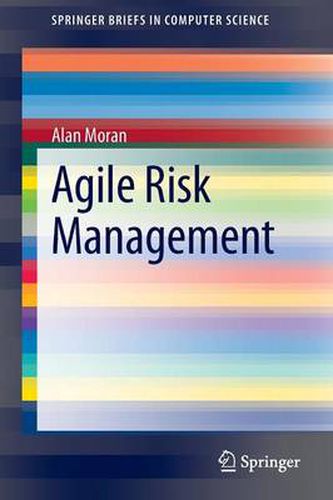Readings Newsletter
Become a Readings Member to make your shopping experience even easier.
Sign in or sign up for free!
You’re not far away from qualifying for FREE standard shipping within Australia
You’ve qualified for FREE standard shipping within Australia
The cart is loading…






This title is printed to order. This book may have been self-published. If so, we cannot guarantee the quality of the content. In the main most books will have gone through the editing process however some may not. We therefore suggest that you be aware of this before ordering this book. If in doubt check either the author or publisher’s details as we are unable to accept any returns unless they are faulty. Please contact us if you have any questions.
This work is the definitive guide for IT managers and agile practitioners. It elucidates the principles of agile risk management and how these relate to individual projects. Explained in clear and concise terms, this synthesis of project risk management and agile techniques is illustrated using the major methodologies such as XP, Scrum and DSDM.
Although the agile community frequently cites risk management, research suggests that risk is often narrowly defined and, at best, implicitly treated, which in turn leads to an inability to make informed decisions concerning risk and reward and a poor understanding of when to engage in risk-related activities. Moreover, the absence of reference to enterprise risk management means that project managers are unable to clearly articulate scope or tailor their projects in line with the wider expectations of the organisation. Yet the agile approach, with its rich toolset of techniques, is very well equipped to effectively and efficiently deal with the risks that arise in projects. Alan Moran addresses the above issues by proposing an agile risk-management process derived from classical risk management but adapted to the circumstances of agile projects. Though his main focus is on the software development process, much of what he describes could be applied to other types of IT projects as well.
This book is intended for anyone who is serious about balancing risk and reward in the pursuit of value for their stakeholders, and in particular for those directly involved in agile software development who share a concern for how risk should be managed. Whilst a thorough background in risk management is not presumed, a basic level of familiarity with or exposure to agility is helpful.
$9.00 standard shipping within Australia
FREE standard shipping within Australia for orders over $100.00
Express & International shipping calculated at checkout
This title is printed to order. This book may have been self-published. If so, we cannot guarantee the quality of the content. In the main most books will have gone through the editing process however some may not. We therefore suggest that you be aware of this before ordering this book. If in doubt check either the author or publisher’s details as we are unable to accept any returns unless they are faulty. Please contact us if you have any questions.
This work is the definitive guide for IT managers and agile practitioners. It elucidates the principles of agile risk management and how these relate to individual projects. Explained in clear and concise terms, this synthesis of project risk management and agile techniques is illustrated using the major methodologies such as XP, Scrum and DSDM.
Although the agile community frequently cites risk management, research suggests that risk is often narrowly defined and, at best, implicitly treated, which in turn leads to an inability to make informed decisions concerning risk and reward and a poor understanding of when to engage in risk-related activities. Moreover, the absence of reference to enterprise risk management means that project managers are unable to clearly articulate scope or tailor their projects in line with the wider expectations of the organisation. Yet the agile approach, with its rich toolset of techniques, is very well equipped to effectively and efficiently deal with the risks that arise in projects. Alan Moran addresses the above issues by proposing an agile risk-management process derived from classical risk management but adapted to the circumstances of agile projects. Though his main focus is on the software development process, much of what he describes could be applied to other types of IT projects as well.
This book is intended for anyone who is serious about balancing risk and reward in the pursuit of value for their stakeholders, and in particular for those directly involved in agile software development who share a concern for how risk should be managed. Whilst a thorough background in risk management is not presumed, a basic level of familiarity with or exposure to agility is helpful.